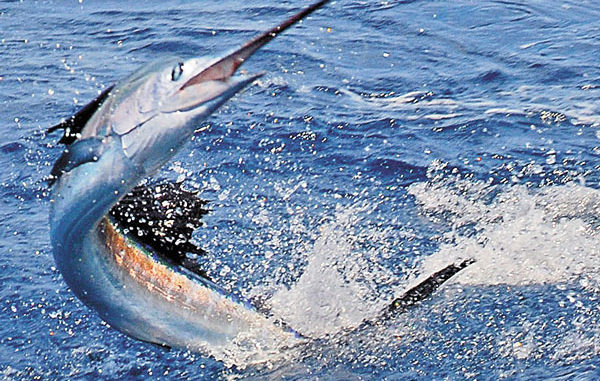
With last winter’s near-record cold a distant memory that was replaced by the long, hot summer, it’s interesting how the natural world has stayed consistently about two weeks behind all year. Nature does not forget a late cold snap, because spring cannot bloom until the last of the frosts have nipped.
Fast forward to this month, and the sailfish bite is just hitting prime time, thanks to the slower cooling of the water, which triggers the arrival of bait and the appearance of sailfish that stalk them.
One consolation for fishermen is that these billfish tend to stay in shallower waters, maybe from 150 to 300 feet deep, and that can really cut down on the fuel bill. Another concession is that rigging is fairly easy, because all the sailfish really want to eat is a “dink ballyhoo” — the smallest size in which they’re sold — and they cost less than the big “horse ballyhoo.” Add a circle hook, and that’s just about it, because sailfish like their bait “naked,” and adding too much tackle will deter the sails.
Some specialty tackle is warranted though, like the squid daisy-chains that should be run alongside either side of the boat as teasers. Then, under the teasers are the dredge rigs, something akin to an underwater umbrella display of ballyhoo or mullet. Two dredge rigs can actually be hooked together to better mimic a large bait ball. Troll six lines behind the boat at about six knots and be sure and keep the right and left flat-lines right behind the dredges on either side in case a sailfish moves in.
Set your drag light because sailfish want to mouth a bait for a minute before they commit to eating it. Sailfish slap the bait around with their bills, which results in a lot of roughed-up leaders, and some have been known to “dog-bone” the ballyhoo — carry it sideways across their mouth. After the strike, disengage the drag and free-line the bait to the sailfish in hopes of getting the hook near its mouth, before ever-so-gently engaging the drag looking for a hookset.
It’s important to remember that once hooked up and fighting a sailfish, a captain will generally want to keep a few lines in the water, because where there is one sailfish, there will be more. A common technique is to keep lines out on the opposite side of the boat from where the sailfish is being fought. A doubleheader on sailfish is a common occurrence, and due to their smaller size, it is a not unreasonable to catch and release them both.
After a hookup, there may be a lull in the action as the bait and the sailfish get their natural ranks reformed, and a few tricks of the trade for re-locating them is to use a depthfinder to mark bait balls, use binoculars to scan the water’s surface for the dorsal fins of sailfish and, of course, pay attention to any type of bird action or schools of fish.
The best sign on the first day of the 2010 Sailfish Slam came when a school of Spanish mackerel smashed the surface with their frothy, animated “semi-jumping,” and the few birds in the area started swooping in on that action lickety split. Clearly, the best spot to troll was close to all that action, and a doubleheader on sailfish was accomplished just like that. First, one sailfish spit the hook, and then the next — we were 0-for-2, but we also saw where the sailfish were keyed in.
The action can get very exciting very quickly, and there is nothing that rules out a big blue marlin from coming into the baits and keeping things interesting. How about five sailfish and a blue marlin in one day’s fishing? It’s quite possible off of the South Carolina coast in December, not to mention that this fall has seen consistent wahoo action, which requires fast-trolling, and even some tuna have been schooling. There has been confirmed yellowfin action this fall, which considering their 2-year absence, is almost reason enough to get offshore.
If anglers become weary of trolling, then just run back in to about 90 to 120 feet of water and drop down some cigar minnows or a Shimano jig for bottom critters like triggerfish, black sea bass and grouper. Be mindful of the regulations affecting red snapper and vermillion snapper, but in general, there should be plenty that tugs on the line that can go towards dinner. Of course, a responsible sportsman keeps no more than he or can use, with a release mentality being a keystone of keeping bottom fisheries sustainable.



Be the first to comment